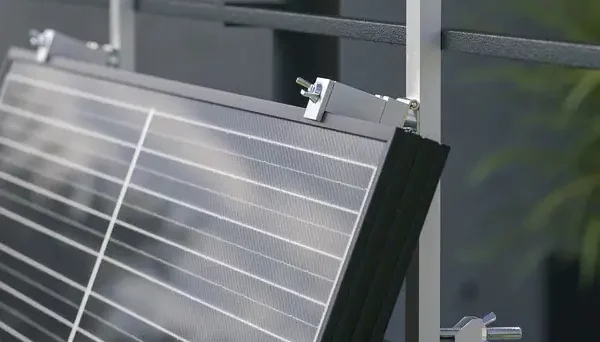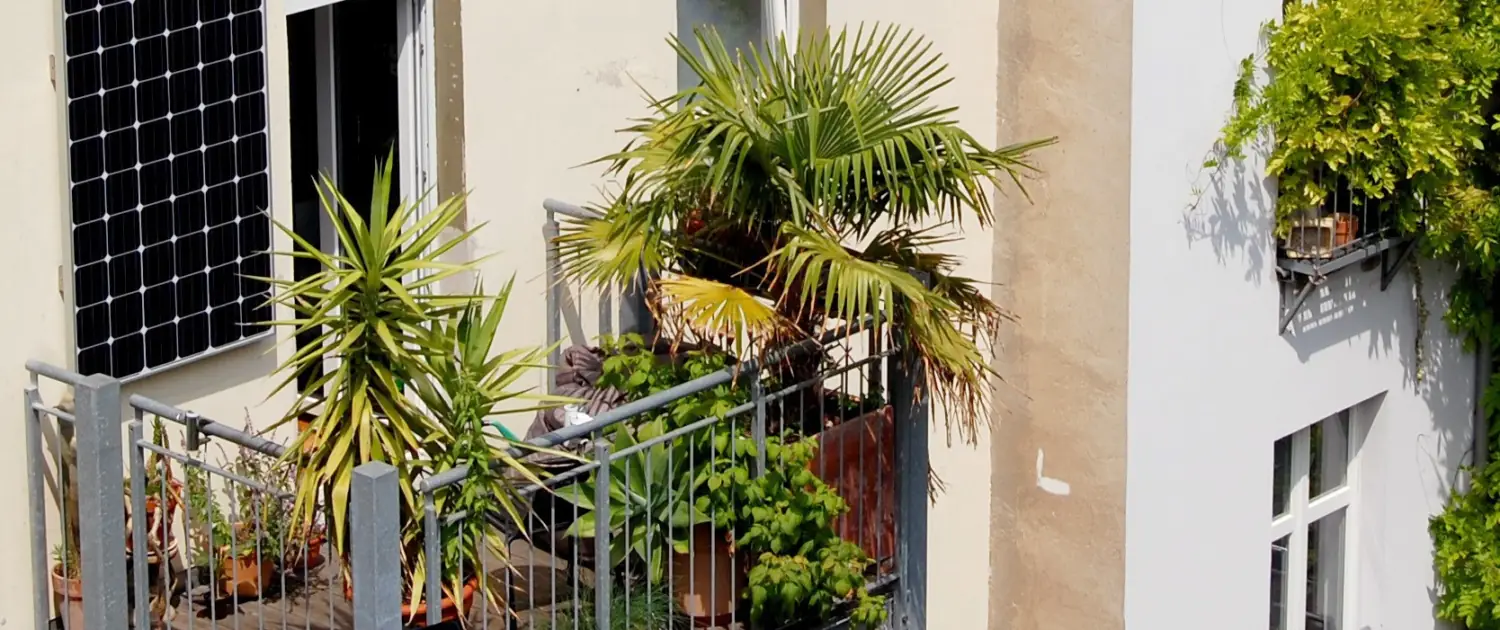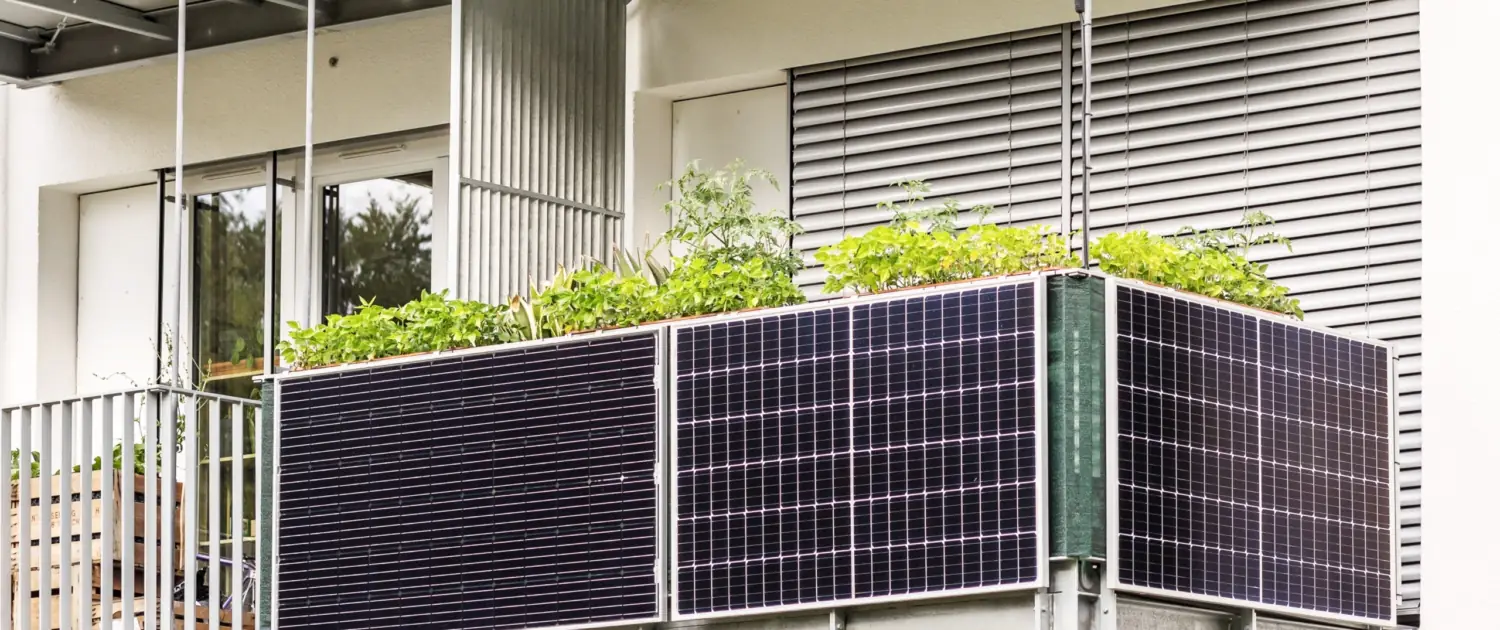Balcony Solar Power Plants – Plug Them into a Socket and They’ll Power a Fridge
Tomáš Grečko is a freelance journalist who writes for the Slovakian Daily N. He is also a fellow of the Climate and Energy Fellowships for Journalists in Europe project funded by EUKI and wrote the following article during his stay in Germany. Originally published in Daily N, his article describes a new trend that has the potential to grow in popularity in Germany and Slovakia.

So-called “plug-in” photovoltaic panels have been a hit in Germany since 2021. People are installing them on balcony railings, on facades or as stand-alone structures in the gardens of houses. At the end of last year, almost 200.000 such systems were reportedly in operation, according to the German Customer Advice Centre. A photovoltaic panel mounted on a south-facing balcony with no shading can generate roughly the equivalent of the annual electricity consumption of an energy-saving fridge and washing machine.
Interest in Germany is so great that the delivery of a mini-photovoltaic system sometimes takes more than a year from the time it is ordered. “But it’s still better than photovoltaic panels on the roof, you’d wait three years for those,” notes an employee at the client centre of German energy firm Süwag. If one wants to have panels faster, one can take a gamble and order them from, for example, Germany’s Amazon, where they can be found at prices starting at 800 euros and up. That is at least a quarter more expensive than what Süwag offers. “People buy them anyway,” says an employee behind the counter at the Frankfurt branch “The reason is that you don’t need any permits to do this, you just attach the panels to the balcony and plug them into a socket at home.” Some German cities even partially fund them.
Project
Further information

Local consumer organisations have launched a process that could ultimately open the way for plug-in panels to be placed on Slovak balconies. “This is a new trend that has the potential to grow in popularity and would probably deserve to be reconsidered in terms of legislation so that its installation is simple and convenient for the consumer, but at the same time safe,” emphasises Miroslav Gejdoš, spokesman for the Slovakian energy company Stredoslovenská distribuční (SSD).
The only way to install balcony panels in a Slovakian apartment building today is to order them from the internet and ask the distribution company to connect a so-called small electricity source. “In addition, this source must also meet the applicable technical conditions,” Gejdoš reminds. This means having a certificate to operate outside the country from which the customer bought it. The same procedure was confirmed by the spokespersons of the West and East Slovak Power Utilities. The connection is therefore carried out as for the installation of conventional photovoltaic panels on the roof of a family house. In most cases, it is also necessary to replace the electricity meter, which, however, takes months in some cases.
In Germany, unlike in Slovakia, new electricity meters are already being installed in flats, which allow a small source of electricity to be connected for self-consumption. If a German household wants to save on the electricity generated on its balcony, it must consume it immediately or store it in a battery, which is not worthwhile at today’s cell prices. The surplus cannot be sold or stored in a ‘virtual battery’ at the supplier. Immediate consumption is usually not a problem, however, as almost every household has a refrigerator that uses electricity.
How it works and how much it costs
– One or two photovoltaic panels are attached to the balcony railing or facade (vertically).
– The system already contains everything needed to generate electricity, including the inverter and cables.
– Through a standard socket, the electricity flows to the wiring in the apartment.
– This makes the electricity meter in the home count slower, as less electricity is drawn from the public grid.
Minisolar power plants from reliable suppliers, who guarantee their performance and take care of service and warranty, cost around 600 to 700 euros for one panel with a maximum output of 300 watts. Under ideal conditions and German electricity prices, which are roughly two to three times higher than those in Slovakia, an investment in photovoltaic panels can pay for itself in as little as five years.
Their installation is relatively simple, but even in Germany, several conditions must be met. First, the apartment that wants them on the balcony should be privately owned. Most inhabitants of larger cities cannot afford to buy their own flat for several hundred thousand euros, so they live in rented ones. In their case, the installation would have to be handled by the owner. Some apartment buildings also have stricter rules for changing the appearance of the facade. In this case, the consent of the other owners is required for the installation of photovoltaic panels on the balcony. The apartment should have the wiring replaced and a more modern meter fitted. In Germany, their replacement is automatically foreseen in the next few years at the latest. If the owner of the apartment requests it earlier, the energy company will usually comply. The electricity supplier must be informed about the installation of small-scale electricity generation equipment in the home, even if you fill in a form on the internet.
Balcony photovoltaic panels only achieve reasonable performance if the sun shines on them for as much of the day as possible. They are therefore recommended for apartments on upper floors with a south-west or south-east orientation. In most cases, the panels are sold in one set with the inverter and cables. The individual components only need to be mounted and soldered together. Even the most technically skilled person can do it.
The performance of a particular installation depends on several parameters. On sunny days, high-quality panels oriented on the right side can produce as much electricity as a refrigerator, the biggest energy guzzler in the home, consumes. Minisolar plants can have a maximum output of 600 watts so that no permits are required. Their sale and use is allowed in Germany by a national standard.
This summer, the German Solar Energy Society completed a project that is expected to lead to the adoption of a uniform standard across the European Union. “The introduction of product standards will contribute to significant market growth as these appliances represent an affordable way for consumers to reduce their electricity consumption,” says project leader Ralf Haselhuhn.

Germans want to generate their own electricity, don’t believe in price drop
In Germany, electricity prices are not regulated as in Slovakia. Currently, the average German household pays two to three times more for electricity than the average Slovak household. An investment in a mini-solar power plant will pay for itself in five years in Germany, whereas in Slovakia it would be ten years at today’s prices.
Germans are willing to wait a year for balcony photovoltaic systems because they expect electricity prices to rise in the future despite the current downturn. “Our energy consultants currently have free dates for personal consultations only in December,” staff at the Consumer Advice Centre in Frankfurt confirmed to a Daily E reporter during a personal visit. The centres help advise people on how to reduce their energy consumption and advise them on how to use renewable energy sources.
The EU’s strategy is that prices should be gradually deregulated everywhere, including here. The European Commission is currently working on legislative proposals to make it easier to connect small sources to the grid. However, they must first be approved by the leaders of the Member States, and then it will be another year before the new rules apply in Slovakia.
Responsible for the content of this page is the named author / organisation:
Tomáš Grečko, journalist Climate and Energy Fellowships for Journalists in Europe
